北师大版(2019)必修第一册Unit 3Celebrations Lesson1 Spring Festival 传统节日写作课件(20张PPT)
文档属性
| 名称 | 北师大版(2019)必修第一册Unit 3Celebrations Lesson1 Spring Festival 传统节日写作课件(20张PPT) | 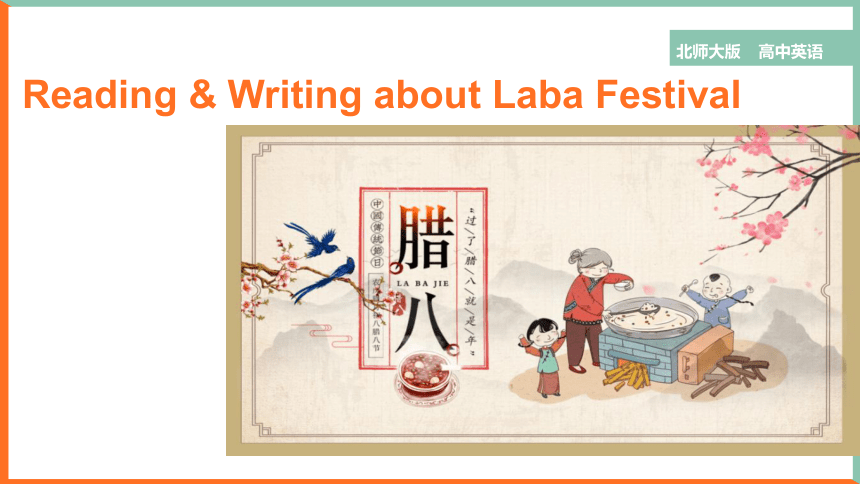 | |
| 格式 | zip | ||
| 文件大小 | 1.5MB | ||
| 资源类型 | 教案 | ||
| 版本资源 | 北师大版(2019) | ||
| 科目 | 英语 | ||
| 更新时间 | 2023-01-01 08:51:35 | ||
图片预览

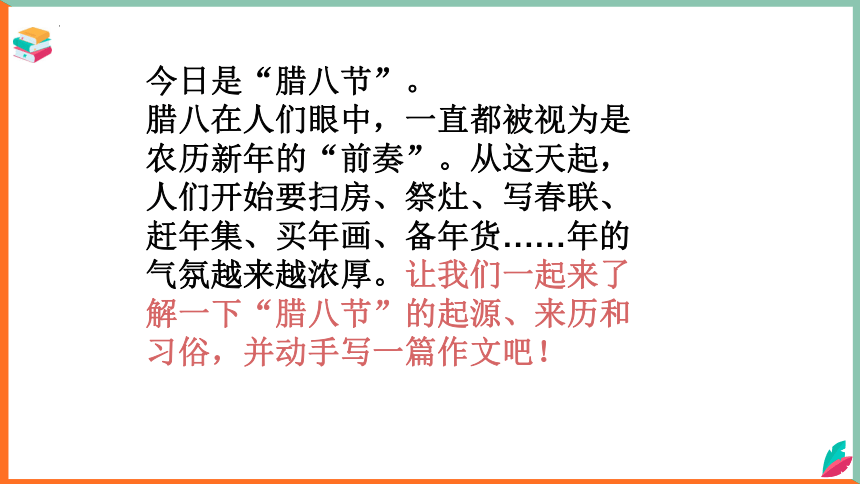
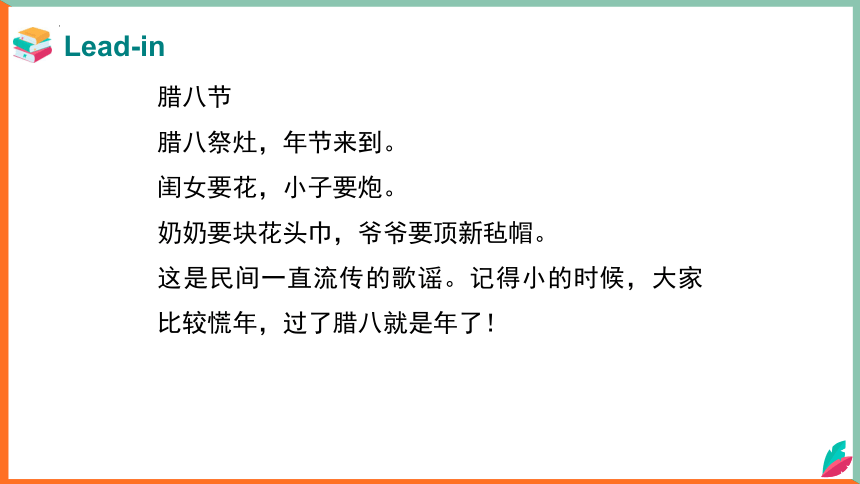
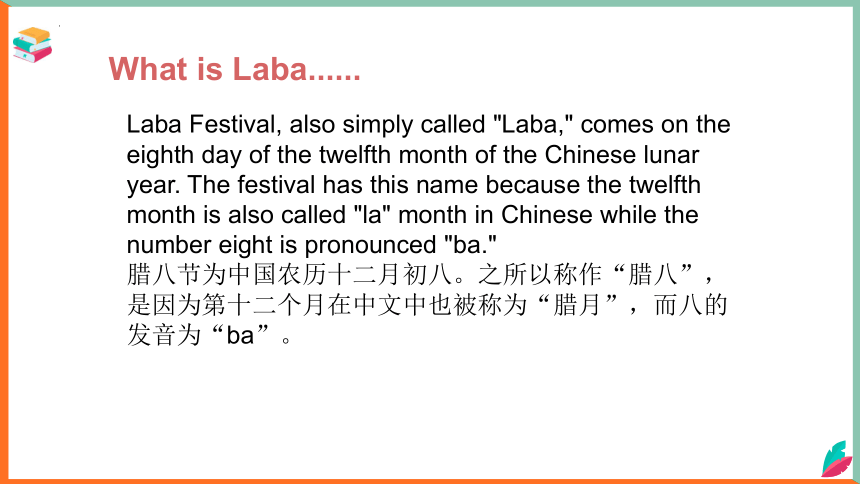

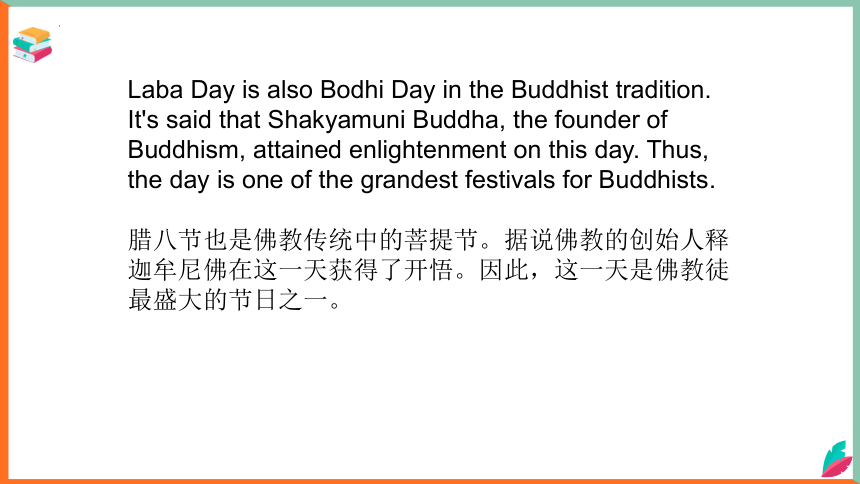
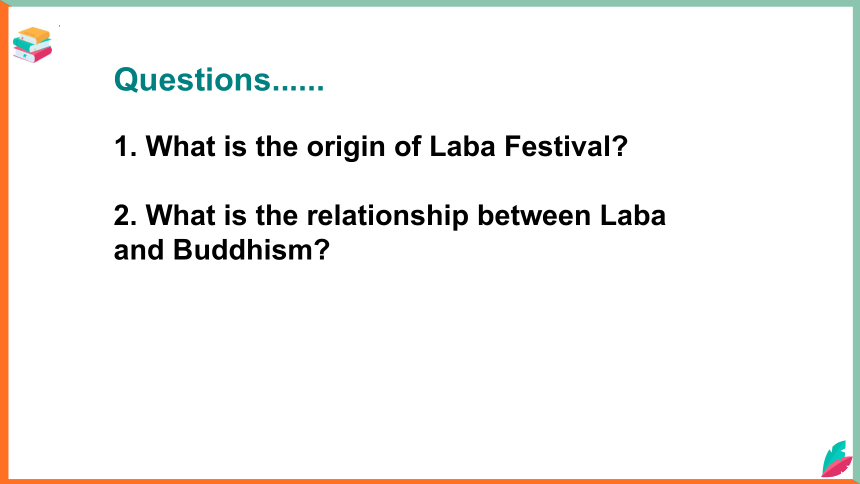
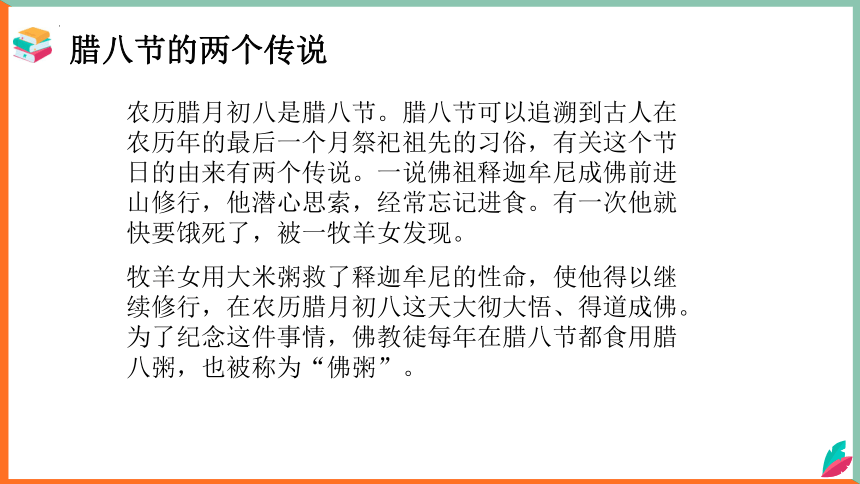
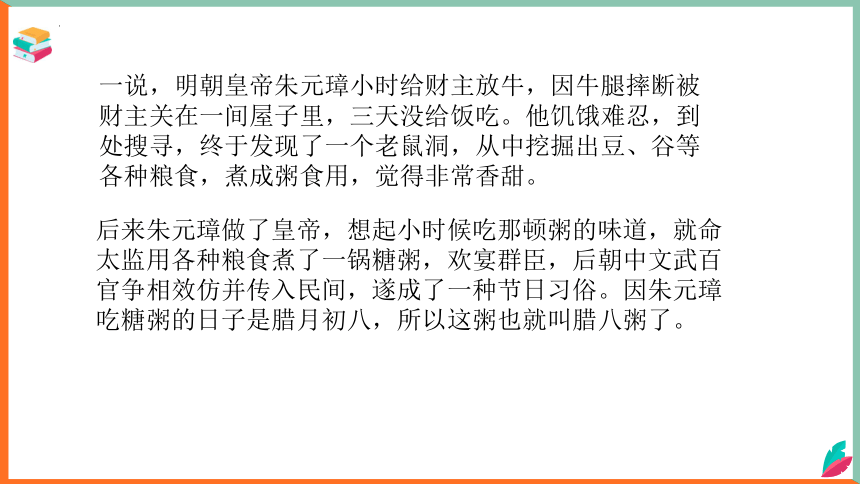
文档简介
(共20张PPT)
Reading & Writing about Laba Festival
北师大版 高中英语
今日是“腊八节”。
腊八在人们眼中,一直都被视为是农历新年的“前奏”。从这天起,人们开始要扫房、祭灶、写春联、赶年集、买年画、备年货……年的气氛越来越浓厚。让我们一起来了解一下“腊八节”的起源、来历和习俗,并动手写一篇作文吧!
腊八节
腊八祭灶,年节来到。
闺女要花,小子要炮。
奶奶要块花头巾,爷爷要顶新毡帽。
这是民间一直流传的歌谣。记得小的时候,大家比较慌年,过了腊八就是年了!
Lead-in
Laba Festival, also simply called "Laba," comes on the eighth day of the twelfth month of the Chinese lunar year. The festival has this name because the twelfth month is also called "la" month in Chinese while the number eight is pronounced "ba."
腊八节为中国农历十二月初八。之所以称作“腊八”,是因为第十二个月在中文中也被称为“腊月”,而八的发音为“ba”。
What is Laba......
Since it's in the last month of the lunar year, the festival implies saying goodbye to the old and embracing the new, and often regarded as a warm-up celebration for the upcoming Spring Festival. As an old saying goes, "after Laba, it's the (Chinese) New Year."
由于它是农历新年的最后一个月,所以意味着辞旧迎新已经开始,是即将到来的春节的热身节庆。俗话说:“过了腊八就是年。”
Laba Day is also Bodhi Day in the Buddhist tradition. It's said that Shakyamuni Buddha, the founder of Buddhism, attained enlightenment on this day. Thus, the day is one of the grandest festivals for Buddhists.
腊八节也是佛教传统中的菩提节。据说佛教的创始人释迦牟尼佛在这一天获得了开悟。因此,这一天是佛教徒最盛大的节日之一。
Questions......
1. What is the origin of Laba Festival
2. What is the relationship between Laba and Buddhism
农历腊月初八是腊八节。腊八节可以追溯到古人在农历年的最后一个月祭祀祖先的习俗,有关这个节日的由来有两个传说。一说佛祖释迦牟尼成佛前进山修行,他潜心思索,经常忘记进食。有一次他就快要饿死了,被一牧羊女发现。
牧羊女用大米粥救了释迦牟尼的性命,使他得以继续修行,在农历腊月初八这天大彻大悟、得道成佛。为了纪念这件事情,佛教徒每年在腊八节都食用腊八粥,也被称为“佛粥”。
腊八节的两个传说
一说,明朝皇帝朱元璋小时给财主放牛,因牛腿摔断被财主关在一间屋子里,三天没给饭吃。他饥饿难忍,到处搜寻,终于发现了一个老鼠洞,从中挖掘出豆、谷等各种粮食,煮成粥食用,觉得非常香甜。
后来朱元璋做了皇帝,想起小时候吃那顿粥的味道,就命太监用各种粮食煮了一锅糖粥,欢宴群臣,后朝中文武百官争相效仿并传入民间,遂成了一种节日习俗。因朱元璋吃糖粥的日子是腊月初八,所以这粥也就叫腊八粥了。
腊八节习俗:祭祀、喝腊八粥、腌腊八蒜是腊八的三大习俗。
Traditions of Laba......
sacrificial rituals:祭祀仪式
make Laba garlic:腌腊八蒜
eight-treasure porridge:腊八粥
eight-treasure porridge:腊八粥
腊八粥
The selection of ingredients for the congee may vary geographically, but generally it include grains like rice, millet, glutinous rice, sorghum, black rice, and coix seeds; beans like soybean, red bean, mung bean, kidney bean, and cowpea; nuts like red dates, peanuts, lotus seeds, goji, chestnuts, raisins, walnuts, and longans.
腊八粥的成分因地域而异,但通常包括谷类,如大米,小米,糯米,高粱,黑米和薏仁;豆类,如大豆,红豆,绿豆,芸豆和豇豆;坚果类,如红枣,花生,莲子,枸杞,栗子,葡萄干,核桃和龙眼等。
常见腊八粥食材英文表达:
glutinous rice 糯米,
red bean 红豆,
millet 小米,
mung 绿豆,
peanuts 花生,
dried lotus seed 干莲子,
dried date 干枣,
almond 杏仁,
oat 燕麦,
buckwheat 荞麦
腊八蒜
In northern China, it's also popular to make Laba garlic. People usually put peeled garlic cloves into a container with vinegar and then seal it up. During the pickling process, the garlic will turn green. It is a typical side dish to have with dumplings during the Spring Festival.
在中国北方,腊八蒜蒜也很受欢迎。人们通常将去皮的蒜瓣放入装有醋的容器中,然后将其密封。在腌制过程中,大蒜会变绿。这是春节期间饺子的典型配菜。
祭祀
One of the festival's traditions is to offer sacrifices to the ancestors and gods. In the agrarian societies of ancient times, this worship was a prayer for good luck and a bountiful harvest.
腊八节的传统之一是祭祀祖先和神灵。在古代的农业社会中,这种祭拜活动用来祈求来年的丰收和好运。
Words and Expressions of Laba......
Laba Festival:腊八,即农历十二月初八,古人有祭祀祖先和神灵、祈求丰收吉祥的传统,一些地区有喝腊八粥的习俗。相传这一天还是佛祖释迦牟尼成道之日,称为“法宝节”,是佛教盛大的节日之一。
the 8th day of the last month of the Chinese lunar calendar:阴历腊月初八
hand out the free porridge:施粥
swarm in:指人们蜂拥而入
auspicious number in Buddhism:佛教中的幸运数字
auspicious:adj. 吉利的;幸运的,吉兆的
sacrificial rituals:祭祀仪式
Sakyamuni:释迦牟尼。古印度宗教家,佛教的创立者。
fatigue and hunger:饥困交加
fatigue:n. / vi. 疲劳,劳累
pray for blessings:祈福
Buddhist follower:佛教信徒
nursing home:养老院
benevolence:n. 慈悲,善举,捐献
chilly winter: 寒冬
You should write a short essay about Laba Festival with the words & expressions in the lesson!
Requirement: about 200 words and neatly write.
THANKS
Reading & Writing about Laba Festival
北师大版 高中英语
今日是“腊八节”。
腊八在人们眼中,一直都被视为是农历新年的“前奏”。从这天起,人们开始要扫房、祭灶、写春联、赶年集、买年画、备年货……年的气氛越来越浓厚。让我们一起来了解一下“腊八节”的起源、来历和习俗,并动手写一篇作文吧!
腊八节
腊八祭灶,年节来到。
闺女要花,小子要炮。
奶奶要块花头巾,爷爷要顶新毡帽。
这是民间一直流传的歌谣。记得小的时候,大家比较慌年,过了腊八就是年了!
Lead-in
Laba Festival, also simply called "Laba," comes on the eighth day of the twelfth month of the Chinese lunar year. The festival has this name because the twelfth month is also called "la" month in Chinese while the number eight is pronounced "ba."
腊八节为中国农历十二月初八。之所以称作“腊八”,是因为第十二个月在中文中也被称为“腊月”,而八的发音为“ba”。
What is Laba......
Since it's in the last month of the lunar year, the festival implies saying goodbye to the old and embracing the new, and often regarded as a warm-up celebration for the upcoming Spring Festival. As an old saying goes, "after Laba, it's the (Chinese) New Year."
由于它是农历新年的最后一个月,所以意味着辞旧迎新已经开始,是即将到来的春节的热身节庆。俗话说:“过了腊八就是年。”
Laba Day is also Bodhi Day in the Buddhist tradition. It's said that Shakyamuni Buddha, the founder of Buddhism, attained enlightenment on this day. Thus, the day is one of the grandest festivals for Buddhists.
腊八节也是佛教传统中的菩提节。据说佛教的创始人释迦牟尼佛在这一天获得了开悟。因此,这一天是佛教徒最盛大的节日之一。
Questions......
1. What is the origin of Laba Festival
2. What is the relationship between Laba and Buddhism
农历腊月初八是腊八节。腊八节可以追溯到古人在农历年的最后一个月祭祀祖先的习俗,有关这个节日的由来有两个传说。一说佛祖释迦牟尼成佛前进山修行,他潜心思索,经常忘记进食。有一次他就快要饿死了,被一牧羊女发现。
牧羊女用大米粥救了释迦牟尼的性命,使他得以继续修行,在农历腊月初八这天大彻大悟、得道成佛。为了纪念这件事情,佛教徒每年在腊八节都食用腊八粥,也被称为“佛粥”。
腊八节的两个传说
一说,明朝皇帝朱元璋小时给财主放牛,因牛腿摔断被财主关在一间屋子里,三天没给饭吃。他饥饿难忍,到处搜寻,终于发现了一个老鼠洞,从中挖掘出豆、谷等各种粮食,煮成粥食用,觉得非常香甜。
后来朱元璋做了皇帝,想起小时候吃那顿粥的味道,就命太监用各种粮食煮了一锅糖粥,欢宴群臣,后朝中文武百官争相效仿并传入民间,遂成了一种节日习俗。因朱元璋吃糖粥的日子是腊月初八,所以这粥也就叫腊八粥了。
腊八节习俗:祭祀、喝腊八粥、腌腊八蒜是腊八的三大习俗。
Traditions of Laba......
sacrificial rituals:祭祀仪式
make Laba garlic:腌腊八蒜
eight-treasure porridge:腊八粥
eight-treasure porridge:腊八粥
腊八粥
The selection of ingredients for the congee may vary geographically, but generally it include grains like rice, millet, glutinous rice, sorghum, black rice, and coix seeds; beans like soybean, red bean, mung bean, kidney bean, and cowpea; nuts like red dates, peanuts, lotus seeds, goji, chestnuts, raisins, walnuts, and longans.
腊八粥的成分因地域而异,但通常包括谷类,如大米,小米,糯米,高粱,黑米和薏仁;豆类,如大豆,红豆,绿豆,芸豆和豇豆;坚果类,如红枣,花生,莲子,枸杞,栗子,葡萄干,核桃和龙眼等。
常见腊八粥食材英文表达:
glutinous rice 糯米,
red bean 红豆,
millet 小米,
mung 绿豆,
peanuts 花生,
dried lotus seed 干莲子,
dried date 干枣,
almond 杏仁,
oat 燕麦,
buckwheat 荞麦
腊八蒜
In northern China, it's also popular to make Laba garlic. People usually put peeled garlic cloves into a container with vinegar and then seal it up. During the pickling process, the garlic will turn green. It is a typical side dish to have with dumplings during the Spring Festival.
在中国北方,腊八蒜蒜也很受欢迎。人们通常将去皮的蒜瓣放入装有醋的容器中,然后将其密封。在腌制过程中,大蒜会变绿。这是春节期间饺子的典型配菜。
祭祀
One of the festival's traditions is to offer sacrifices to the ancestors and gods. In the agrarian societies of ancient times, this worship was a prayer for good luck and a bountiful harvest.
腊八节的传统之一是祭祀祖先和神灵。在古代的农业社会中,这种祭拜活动用来祈求来年的丰收和好运。
Words and Expressions of Laba......
Laba Festival:腊八,即农历十二月初八,古人有祭祀祖先和神灵、祈求丰收吉祥的传统,一些地区有喝腊八粥的习俗。相传这一天还是佛祖释迦牟尼成道之日,称为“法宝节”,是佛教盛大的节日之一。
the 8th day of the last month of the Chinese lunar calendar:阴历腊月初八
hand out the free porridge:施粥
swarm in:指人们蜂拥而入
auspicious number in Buddhism:佛教中的幸运数字
auspicious:adj. 吉利的;幸运的,吉兆的
sacrificial rituals:祭祀仪式
Sakyamuni:释迦牟尼。古印度宗教家,佛教的创立者。
fatigue and hunger:饥困交加
fatigue:n. / vi. 疲劳,劳累
pray for blessings:祈福
Buddhist follower:佛教信徒
nursing home:养老院
benevolence:n. 慈悲,善举,捐献
chilly winter: 寒冬
You should write a short essay about Laba Festival with the words & expressions in the lesson!
Requirement: about 200 words and neatly write.
THANKS
同课章节目录
- Unit 1 Life Choices
- Lesson 1 Lifestyles
- Lesson 2 Understanding and Coping with Stress
- Lesson 3 Your Life Is What You Make It
- Unit 2 Sports and Fitness
- Lesson 1 The Underdog
- Lesson 2 Rules of the Game
- Lesson 3 Running and Fitness
- Unit 3 Celebrations
- Lesson 1 Spring Festival
- Lesson 2 Special Occasions
- Lesson 3 Memories of Christmas
